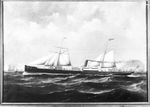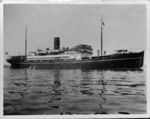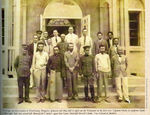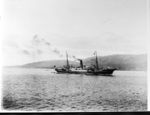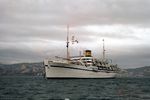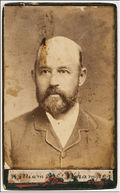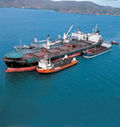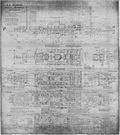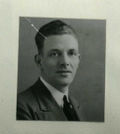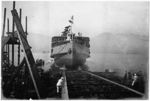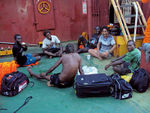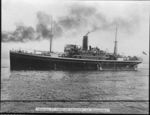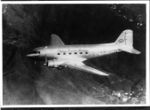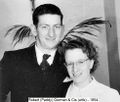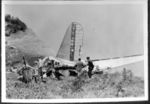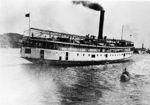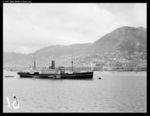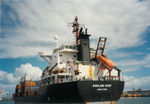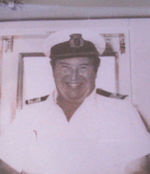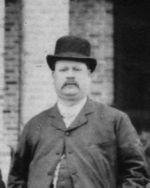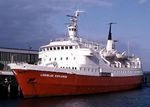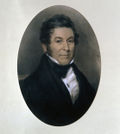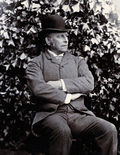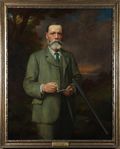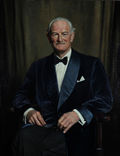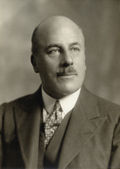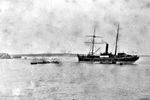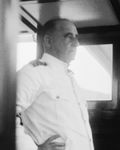Template:Featured articles
Contents
2012
Featured articles for 2012
January
The Loss of Changchow
A file of unremarkable press clippings are all that remain to tell the tale of the last voyage of Changchow in 1884 – a voyage that was in many respects an unusual one.
Changchow was at this time just two years old - the product of an energetic newbuilding programme for China Navigation’s rapidly expanding China coast trade. In 1883, less than a year after delivery, she was switched to the company’s new liner service to Australia - a trade which also employed her sister ship Taiwan, as well as the three-year-old (and somewhat smaller) Keelung, supplemented in the all-important tea season by Keelung’s two sisters, Hoihow and Tamsui. Click here for more...
February
The Loss of Changchow
A file of unremarkable press clippings are all that remain to tell the tale of the last voyage of Changchow in 1884 – a voyage that was in many respects an unusual one.
Changchow was at this time just two years old - the product of an energetic newbuilding programme for China Navigation’s rapidly expanding China coast trade. In 1883, less than a year after delivery, she was switched to the company’s new liner service to Australia - a trade which also employed her sister ship Taiwan, as well as the three-year-old (and somewhat smaller) Keelung, supplemented in the all-important tea season by Keelung’s two sisters, Hoihow and Tamsui. Click here for more...
March
Loss of a Gallant Ship
An enquiry by the family of a Royal Artillery gunner killed onboard a China Navigation ship during World War II led to an interesting search through Swire and Admiralty records to try to piece together the last hours of S.S. Shuntien, torpedoed in the Mediterranean in December 1941.
Shuntien, (3059 gross tons), was built by Taikoo Dockyard in 1934 for China Navigation’s Shanghai-Tianjin service. At that time, she was one of the fastest vessels in the fleet, with a normal speed of 16 knots but capability of going much faster. She was compact at just 300 feet long, to allow her to manoeuvre in the river at Tianjin, and had a strengthened, icebreaker bow. Click here for more...
April
Loss of a Gallant Ship
An enquiry by the family of a Royal Artillery gunner killed onboard a China Navigation ship during World War II led to an interesting search through Swire and Admiralty records to try to piece together the last hours of S.S. Shuntien, torpedoed in the Mediterranean in December 1941.
Shuntien, (3059 gross tons), was built by Taikoo Dockyard in 1934 for China Navigation’s Shanghai-Tianjin service. At that time, she was one of the fastest vessels in the fleet, with a normal speed of 16 knots but capability of going much faster. She was compact at just 300 feet long, to allow her to manoeuvre in the river at Tianjin, and had a strengthened, icebreaker bow. Click here for more...
May
The Manchurian Affair
At dawn on a chilly March morning in 1933, the China Navigation Company’s 2,480-ton coaster Nanchang rode at anchor in the estuary of the Liao River, awaiting a pilot to take her the nineteen miles upriver to Newchwang, the old beancaking port on the Gulf of Liao-Tung in northeastern Manchuria.
Just a year and half before, the Japanese Army had invaded the province, establishing the “independant” state of Manchukuo under the puppet leadership of the deposed playboy Emperor, Henry Pu-Yi. The Nationalist forces had fled, leaving a few stragglers to scratch a living from the bleak landscape as outlaws. The once thriving foreign community had dwindled to a handful and the trappings of European life on the China coast - the tennis club and the golf course - had fallen into disrepair. Click here for more...
June
The Inglorious Fate of the Indigirka (Tsinan I)
In the late 1880s, John Samuel Swire commissioned Clyde shipbuilders Scotts’ Shipbuilding & Engineering, to build a new class of steamship for the Far East-Australia trade. Launched in 1886, Changsha I, Taiyuan I, Chingtu and Tsinan I, with their sleek, yacht-like lines, were undoubtedly the prettiest ships ever owned by the China Navigation Company, and they were immediately popular with passengers.Click here for more...
July
The Loss of Changchow
A file of unremarkable press clippings are all that remain to tell the tale of the last voyage of Changchow in 1884 – a voyage that was in many respects an unusual one.
Changchow was at this time just two years old - the product of an energetic newbuilding programme for China Navigation’s rapidly expanding China coast trade. In 1883, less than a year after delivery, she was switched to the company’s new liner service to Australia - a trade which also employed her sister ship Taiwan, as well as the three-year-old (and somewhat smaller) Keelung, supplemented in the all-important tea season by Keelung’s two sisters, Hoihow and Tamsui. Click here for more...
August
Captain Evans of Anhui
In late September 1941, less than three months before the Japanese airforce bombed the American fleet at Pearl Harbor on 7th December, Anhui II, under the command of Captain (later Commodore) Llewellyn Evans, was ordered to Japan to evacuate foreign nationals to Hong Kong, Singapore and Calcutta.
Sailing south from Yokohama with 370 mainly British and Indian passengers on board, the 3,500-ton vessel battled her way through one of the worst typhoons in living memory. The ship was pounded by 140 mile-an-hour winds and four of her eight lifeboats were ripped from their davits. By the time they made port in Hong Kong, the gallant Captain Evans - who had stayed on the bridge for 24 hours to nurse his ship through the worst of the storm - was a hero to his passengers. Anhui, meanwhile, had begun to acquire a reputation as a “lucky” ship. Click here for more...
September
Captain Evans of Anhui
In late September 1941, less than three months before the Japanese airforce bombed the American fleet at Pearl Harbor on 7th December, Anhui II, under the command of Captain (later Commodore) Llewellyn Evans, was ordered to Japan to evacuate foreign nationals to Hong Kong, Singapore and Calcutta.
Sailing south from Yokohama with 370 mainly British and Indian passengers on board, the 3,500-ton vessel battled her way through one of the worst typhoons in living memory. The ship was pounded by 140 mile-an-hour winds and four of her eight lifeboats were ripped from their davits. By the time they made port in Hong Kong, the gallant Captain Evans - who had stayed on the bridge for 24 hours to nurse his ship through the worst of the storm - was a hero to his passengers. Anhui, meanwhile, had begun to acquire a reputation as a “lucky” ship. Click here for more...
October
Engine Failures Aboard Soochow III
1960, Main Engine breakdown. Terry Connell who was 2nd. Mate at the time, describes the incident, and this is reproduced here by his kind permission. Frank Hindle was Master, J.K.Davies 1st. Mate, Hamish McDonald Chief Engineer.
We had almost finished loading in Sydney so I was doing the usual setting out of our Northbound courses to Brisbane on our well-used chart, which as you will all know are set close to the coast so as to avoid the South setting current which runs strongest along the the 100 fathom line. Click here for more...
November
Engine Failures Aboard Soochow III
1960, Main Engine breakdown. Terry Connell who was 2nd. Mate at the time, describes the incident, and this is reproduced here by his kind permission. Frank Hindle was Master, J.K.Davies 1st. Mate, Hamish McDonald Chief Engineer.
We had almost finished loading in Sydney so I was doing the usual setting out of our Northbound courses to Brisbane on our well-used chart, which as you will all know are set close to the coast so as to avoid the South setting current which runs strongest along the the 100 fathom line. Click here for more...
December
Loss of a Gallant Ship
An enquiry by the family of a Royal Artillery gunner killed onboard a China Navigation ship during World War II led to an interesting search through Swire and Admiralty records to try to piece together the last hours of S.S. Shuntien, torpedoed in the Mediterranean in December 1941.
Shuntien, (3059 gross tons), was built by Taikoo Dockyard in 1934 for China Navigation’s Shanghai-Tianjin service. At that time, she was one of the fastest vessels in the fleet, with a normal speed of 16 knots but capability of going much faster. She was compact at just 300 feet long, to allow her to manoeuvre in the river at Tianjin, and had a strengthened, icebreaker bow. Click here for more...
2013
Featured articles for 2013
January
WWII Reminiscences of CNCo Master, Andrew Watson
My earliest recollection of the part I was destined to play in World War 2 seems to me, at this late stage, to begin at Tongku in North China, and the China Navigation ship Chekiang in which I was serving as Chief Officer. The date was 4th Dec. 1941, and Chekiang, having completed bunkering, was ready to leave the pontoon but was, unfortunately, heading the wrong way, and would have to swing at the berth before doing so. Much anti-British feeling was in evidence at this time, sponsored by the Japanese Military who were in virtual control of all N. China ports Click here for more...
February
An Ill-fated Ship
Tungchow was built by Taikoo Dockyard in 1914 for the China Navigation Company’s Shanghai-Tianjin passenger service. She was an ill-fated ship. On 18th December 1925, Tungchow was seized by pirates, 200 miles south of Weihai, when southbound from Tianjin to Shanghai and whilst in sight of another CNCo coaster, Linan. Click here for more...
March
First-Class Cruising
Built as the Dilwara, Kuala Lumpur was the first purpose-built British troopship since the 1860s. She narrowly survived World War II, took an active role in the Korean campaign and was also involved in the Suez crisis. With CNCo she began a new life as a first-class cruise ship principally carrying Malay pilgrims to Jeddah. Click here for more...
April
Captain James E Williams
Captain James E Williams, commander of the steamer Chingtu,at the time of his death, had been in the service of the China Navigation Company for upwards of 25 years and was the commodore of the fleet. For nearly 20 years he was engaged in the trade between China and Australia, first as master of the Whampoa in 1883, then of Changsha, and eventually as commander of the Chingtu, to which vessel he was transferred about six years before his death. Captain Williams was regarded as an extremely capable and careful navigator, and during his lengthy connection with the China Navigation Company never had an accident of a serious character. He was popular with the shipping community and the travelling public. Captain Williams died on board his vessel at sea, and upon the arrival of the Chingtu at Townsville was buried at Brampton Island. Click here for more...
May
Erawan - End of an Era
In 1999, CNCo acquired the Japanese-built 64,000dwt Panamax bulk carrier Camerina – then 18 years old – and successfully tendered for the role of Ok Tedi’s “mother ship”. The bulker was duly brought up to CNCo standards and equipped with a heli-deck, three 30-ton heavy-duty,articulated grab cranes, sophisticated weighing equipment(designed to meet an extremely tight contractual accuracy of 0.5%) and special stainless steel grabs. Other equipment installed included two extra generators, a high-capacity evaporator (desalination plant), fuel transfer systems and extra accommodation, as well as upgraded mooring and coating systems. Erawan, as she now became, went on charter in April 2000. Click here for more...
June
Yangtze Reminiscences
Graham Torrible was born in 1904 and joined The China Navigation Company as a deck officer in 1925. He served on the China Coast and Yangtze River during the 1920s and 1930s and was interned at Bangkok during the Second World War. He was Acting Marine Superintendent of C.N.Co. at Shanghai from 1948 until 1950. Torrible returned to sea in 1950 to take command of C.N.Co.'s new passenger liner Chungking III, on charter to Messageries Maritimes for their Marseilles/Tahiti/Sydney service. In 1953, he was appointed Marine Superintendent of C.N.Co. at Hong Kong and retired from the Company in 1961. He initially returned to the UK for his retirement but is recorded as having told a friend "how unhappy and unsettled he felt when he retired back to the UK....He said he felt that he was on a different wave-length from the British who had not ventured abroad, and found them very insular..." When the opportunity arose Torrible lept at the opportunity to return to Hong Kong and he died there in 1995 Click here for more...
July
Shengking II GA Plan
Recently uploaded to WikiSwire is this large and detailed (1/8" = 1 foot) general arrangement plan of the Shengking II dated July 1947. Shengking II was built by Scotts of Greenock and delivered to the CNCo on the 4th December 1931. She was built for the Shanghai - Tianjin express service, was powered by 3,400hp twin-screw steam turbines and had an ice-breaking bow. During the Second World War the Shengking II was requisitioned by the Ministry of War Transport (MOWT) and served with the Royal Fleet Auxiliary as a supply ship in the Indian Ocean. The General Arrangement plan here undoubtedly illustrates Shengking's post war refurbishment and her deployment to the weekly Hong Kong - Shanghai service. Click here for more...
August
Hamish Macdonald
After an apprenticeship with J.L.Thorneyroft & Co. Hamish Macdonald joined the Cunard Line as 23rd / 22nd Engineer on the S.S. Mauritania. On joining his initial station, on standby when entering and leaving port, was looking after the propellor shaft bearings etc. After 3 1/2 years with the Cunard Line he obtained his 2nd class certificate (steam) No. 65708. During the oral examination the examiner asked him what was the material used in bilge pipework, he replied "copper", to which the examiner replied;- "you are another engineer from the Mauritania" January 5th. 1928. Joined the service of The China Navigation Co. and stayed with the company until his retirement on July 16th. 1967 Click here for more...
September
CNCo Commodores
The title of CNCo 'Commodore' is a purely ceremonial recognition given to the longest serving Master in the fleet. As the image here demonstrates it was possible to reach the number one spot on the seniority list and become 'Commodore' without having the longest service. Length of service as 'Master' was the determing factor.
A complete list of CNCo Commodores is not known. It is indeed possible that at the end of the 19th century there was a 'Commodore' for both river and coastal vessels. We may never know. Click here for a full list from 1943 to the present day...
October
The Mystery of Shanghai
This dramatic photograph shows the Yangtze River steamer Shanghai, built at Hongkong & Whampoa Dockyard’s (“HWD”) Kowloon Dock, and launched by Lady William Meigh Goodman, wife of the Chief Justice, on 14th July 1904. At the time, Shanghai was the largest vessel ever built in Hong Kong – a proud day indeed for CNCo and for HWD.
The only problem is that so far as CNCo’s records are concerned, this vessel never existed: the only Shanghai to join the CNCo fleet was a paddlesteamer built in Glasgow in 1873 – so what on earth became of her 1904 namesake? Click here for more...
November
Rescue at Sea
Highland Chief was leaving Honaira on 16th June 2013 when the bridge duty officer spotted the faint outline of a life raft on the water. The Man Overboard alarm was sounded and the rescue operation immediately swung into action.
The six people rescued were the crew of Global Lestary, a 146 GRT landing craft, operating under the Solomon Islands flag. Their vessel was carrying logs from Isabel Province to Honiara, when it got caught in bad weather, started taking in water and subsequently listed, with logs falling overboard. Click here for more...
December
Rescue at Sea
Highland Chief was leaving Honaira on 16th June 2013 when the bridge duty officer spotted the faint outline of a life raft on the water. The Man Overboard alarm was sounded and the rescue operation immediately swung into action.
The six people rescued were the crew of Global Lestary, a 146 GRT landing craft, operating under the Solomon Islands flag. Their vessel was carrying logs from Isabel Province to Honiara, when it got caught in bad weather, started taking in water and subsequently listed, with logs falling overboard. Click here for more...
2014
Featured articles for 2014
January
The Manchurian Affair
At dawn on a chilly March morning in 1933, the China Navigation Company’s 2,480-ton coaster Nanchang rode at anchor in the estuary of the Liao River, awaiting a pilot to take her the nineteen miles upriver to Newchwang, the old beancaking port on the Gulf of Liao-Tung in northeastern Manchuria.
Just a year and half before, the Japanese Army had invaded the province, establishing the “independent” state of Manchukuo under the puppet leadership of the deposed playboy Emperor, Henry Pu-Yi. The Nationalist forces had fled, leaving a few stragglers to scratch a living from the bleak landscape as outlaws. The once thriving foreign community had dwindled to a handful and the trappings of European life on the China coast - the tennis club and the golf course - had fallen into disrepair. Click here for more...
February
The Last Days of Capt. Christie of the Hoihow
When day broke on the 3rd we discerned far off what at first appeared to be driftwood. As the morning advanced we drifted nearer and discovered it to be Captain Christie, who had been night long clinging to a wooden companionway. It was some time before we could get close enough to throw him a rope and get him aboard our raft. He was very exhausted and clothed only in a raincoat and life-jacket. I'm afraid there was little comfort or room for the six of us on the raft. He had contracted several sores during the night in his efforts to hold on to the companionway, and these I was able to dress with the first aid outfit, Later, after we had got over a sea anchor and had all had a drink of water we exchanged stories. Click here for more...
March
The New Guinea Australia Line
The China Navigation Company first became involved in the Papua New Guinea trade in 1939, when Yunnan took over the copra trade from the German company Nord Deutscher Lloyd, (now Hapag Lloyd) which had been banished from Allied territorial waters by the outbreak of World War II in Europe. In those early days, special boats were carried on board to lift copra directly from the beaches. Needless to say, this service ceased with the start of the Pacific War, and CNCo did not re-enter the trade until December 1952, when an Australia-Papua New Guinea service was inaugurated as part of a long-term development plan to give the company an Australian base. This trade, together with that to the Solomons and New Hebrides, had previously been monopolised by the Australian line Burns Philp – then the largest operator in New Guinea – which also generated much of the cargo. However, the rapid post-war growth of trade between Australia and PNG made room for an additional carrier. Click here for more...
April
The Inglorious Fate of the Indigirka (Tsinan I)
In the late 1880s, John Samuel Swire commissioned Clyde shipbuilders Scotts’ Shipbuilding & Engineering, to build a new class of steamship for the Far East-Australia trade. Launched in 1886, Changsha I, Taiyuan I, Chingtu and Tsinan I, with their sleek, yacht-like lines, were undoubtedly the prettiest ships ever owned by the China Navigation Company, and they were immediately popular with passengers.Click here for more...
May
The Loss of Changchow
A file of unremarkable press clippings are all that remain to tell the tale of the last voyage of Changchow in 1884 – a voyage that was in many respects an unusual one.
Changchow was at this time just two years old - the product of an energetic newbuilding programme for China Navigation’s rapidly expanding China coast trade. In 1883, less than a year after delivery, she was switched to the company’s new liner service to Australia - a trade which also employed her sister ship Taiwan, as well as the three-year-old (and somewhat smaller) Keelung, supplemented in the all-important tea season by Keelung’s two sisters, Hoihow and Tamsui. Click here for more...
June
The Piracy of the Anking
Anking with 1400 people on board, was pirated in the Gulf of Tongkin, on the 26th September 1928, whilst en route from Singapore to Hoihow. As was so often the case, the pirates, about 40 in total, had come aboard the ship disguised as deck passengers. Click here for more...
July
Captain Evans of Anhui
In late September 1941, less than three months before the Japanese airforce bombed the American fleet at Pearl Harbor on 7th December, Anhui II, under the command of Captain (later Commodore) Llewellyn Evans, was ordered to Japan to evacuate foreign nationals to Hong Kong, Singapore and Calcutta.
Sailing south from Yokohama with 370 mainly British and Indian passengers on board, the 3,500-ton vessel battled her way through one of the worst typhoons in living memory. The ship was pounded by 140 mile-an-hour winds and four of her eight lifeboats were ripped from their davits. By the time they made port in Hong Kong, the gallant Captain Evans - who had stayed on the bridge for 24 hours to nurse his ship through the worst of the storm - was a hero to his passengers. Anhui, meanwhile, had begun to acquire a reputation as a “lucky” ship. Click here for more...
August
An Ill-fated Ship
Tungchow was built by Taikoo Dockyard 100 years ago in 1914 for the China Navigation Company’s Shanghai-Tianjin passenger service. She was an ill-fated ship. On 18th December 1925, Tungchow was seized by pirates, 200 miles south of Weihai, when southbound from Tianjin to Shanghai and whilst in sight of another CNCo coaster, Linan. Click here for more...
September
Betsy - Cathay Pacific Airways' First Aircraft
The relationship between this DC3, affectionately known as "Betsy" and Cathay Pacific Airways started as early as 1945. Originally planned as a civil DC3/360, the aircraft was taken over by the military before construction was completed and designated a C47. It was delivered to the United States Army Air Corps on June 4 1942 and in August 1943 was deployed overseas with the U.S. military but so far no details are known as to which theatre of war it served. Click here for more...
October
Gandhi's Ashes
In 2014 John Swire & Sons’ archives department acquired the log book of Captain Stanley Victor Leslie, an Australian pilot who joined Cathay Pacific Airways in 1946, after war service in New Guinea and the Pacific. An interesting entry for 15th March 1948 records that on that day, Vic Leslie took off from Mingladon Airport in Rangoon in one of the airline’s seven DC-3s – VR-HDA, also known as “Niki”. His route took him to Bangkok and then on to Singapore, where he made a night landing at Kallang Airport. Amongst his passengers were two representatives from the Government of India, en route from New Delhi and escorting an urn containing ashes from the funeral pyre of the recently assassinated leader of the Indian independence movement, Mahatma Gandhi. Click here for more...
November
Captain James E Williams
Captain James E Williams, commander of the steamer Chingtu,at the time of his death, had been in the service of the China Navigation Company for upwards of 25 years and was the commodore of the fleet. For nearly 20 years he was engaged in the trade between China and Australia, first as master of the Whampoa in 1883, then of Changsha, and eventually as commander of the Chingtu, to which vessel he was transferred about six years before his death. Captain Williams was regarded as an extremely capable and careful navigator, and during his lengthy connection with the China Navigation Company never had an accident of a serious character. He was popular with the shipping community and the travelling public. Captain Williams died on board his vessel at sea, and upon the arrival of the Chingtu at Townsville was buried at Brampton Island. Click here for more...
December
Captain Robert 'Paddy' Gorman
"I had only just gone to sleep (on the Yochow) - Yochow II - when I was woken by the sensation of being phyiscally lifted from my bunk. I got my tin helmet and rushed to my gun post. These gun posts were deadly things, as they were surrounded by cement blocks that broke into deadly pointed pieces when a direct hit was scored on them. My gun post was blown to smithereens and the two gunners who were inside were in a terrible condition. I went for a boat to get them ashore, and their words still ring in my memory to this day, as we tried to make them more comfortable in the skiff. "Please shoot me - this is more than I can bear", which petrified me with terror, as they were really asking so little.". Click here for more...
2015
Featured articles for 2015
January
VR-HDG Braemar Reservoir Crash
The aircraft, captained by Johnny Paish, had approached Kai Tak's runway 07 in thick fog and, although the pilot could see the runway from the Hung Hom beacon, he subsequently lost visual contact and elected to turn right and circle to land on runway 31. Losing sight of the airfield again, whist heading downwind for this landing, Captain Paish carried out a 'missed approach' straight towards Hong Kong Island. The aircraft struck the lip of the Braemar Reservoir at a height of 400 feet, broke up and caught fire. All on board were killed. Click here for more...
February
Mr Smith goes to Canton
It struck me before leaving that there seemed a goodish lot of young fellows going to Canton, and although dressed in civvies, I had most of ’em plotted as ploughers of the sea. We had no more than cast off, however, before the lads got busy, and, to my surprise, actively prepared with machine guns and other implements of war, to do battle against Chinese pirates, whose depredations have lately been quite considerable. A whisper regarding an impending attack on the Fatshan resulted in her carrying several naval men and it was these I had noticed so particularly earlier. Click here for more...
March
Out of Season Cruising
The Kuala Lumpur was acquired by The China Navigation Company (CNCo) in 1960 to carry Muslim pilgrims to Jeddah. Out of season (August-November), the ship was employed as a cruise vessel between Australia, New Zealand, the South Pacific and Japan. There was a considerable market for educational tours out of New Zealand and the summer schedules usually included schoolboy tours. The ss Kuala Lumpur's penultimate cruise involved the carriage of New Zealand boy scouts to a scout jamboree in Japan via South Pacific and Far Eastern ports. The master, J.B.H.J. Aldiss, was a key figure in these cruising activities. Click here for more...
April
The Manchurian Affair
At dawn on a chilly March morning in 1933, the China Navigation Company’s 2,480-ton coaster Nanchang rode at anchor in the estuary of the Liao River, awaiting a pilot to take her the nineteen miles upriver to Newchwang, the old beancaking port on the Gulf of Liao-Tung in northeastern Manchuria.
Just a year and half before, the Japanese Army had invaded the province, establishing the “independent” state of Manchukuo under the puppet leadership of the deposed playboy Emperor, Henry Pu-Yi. The Nationalist forces had fled, leaving a few stragglers to scratch a living from the bleak landscape as outlaws. The once thriving foreign community had dwindled to a handful and the trappings of European life on the China coast - the tennis club and the golf course - had fallen into disrepair. Click here for more...
May
Charles O'Neill of the Anking
Dear Mrs O'Neill, Lieutenant McWilliams was telling me about you and that you were trying to find out all about your husband who was on the Anking when she got sunk 4th March last year. Well Mrs O'Neill I will tell you all I know and what I say will be the truth – I know you want that. After the ship went we were all on the rafts and broken up lifeboats and I was one of the many who were on the same raft as your husband. We were all in good spirits just then, you see we all thought we would be picked up within a few hours. Your husband was wounded, I am sorry to say, but I didn't think it was serious because I heard a doctor who was with us say it wasn't bad. The doctor was lost just after that. At one time Mr O'Neill was bleeding a little bit and we tied one of his stockings around the wound and it was all right then. You see they were shrapnel wounds and I will honestly say that your husband was never complaining he said he was all right and even said to us “Stick it out” and that we should make it.. Click here for more...
June
Rescue at Sea
Highland Chief was leaving Honaira on 16th June 2013 when the bridge duty officer spotted the faint outline of a life raft on the water. The Man Overboard alarm was sounded and the rescue operation immediately swung into action.
The six people rescued were the crew of Global Lestary, a 146 GRT landing craft, operating under the Solomon Islands flag. Their vessel was carrying logs from Isabel Province to Honiara, when it got caught in bad weather, started taking in water and subsequently listed, with logs falling overboard. The crew had to abandon their vessel, which quickly capsized and sank, and take to the six-man life raft. Click here for more...
July
Captain John Storey
John Storey joined CNCo in August 1933 in Shanghai. He was 23 and his 1st Mate's Certificate of Competency had been issued in Leith the previous year.
Captain Storey sailed with CNCo for 23 years and wrote about his experiences. One episode he recounts relates to his appointment as Master of the Siangtan and his journey across country to Ichang to meet the ship. Click here for more...
August
Loss of a Gallant Ship
An enquiry by the family of a Royal Artillery gunner killed onboard a China Navigation ship during World War II led to an interesting search through Swire and Admiralty records to try to piece together the last hours of S.S. Shuntien, torpedoed in the Mediterranean in December 1941.
Shuntien, (3059 gross tons), was built by Taikoo Dockyard in 1934 for China Navigation’s Shanghai-Tianjin service. At that time, she was one of the fastest vessels in the fleet, with a normal speed of 16 knots but capability of going much faster. She was compact at just 300 feet long, to allow her to manoeuvre in the river at Tianjin, and had a strengthened, icebreaker bow. Click here for more...
September
Donald Hutchinson
Donald Hutchinson, known to most close to him as 'Hutch', was a larger than life figure in every sense of the meaning. He worked hard and played hard. Hutch loved pomp and ceremony and thus his appointment as Master of M.S. Coral Princess suited him well. Whether declaring, at short notice, that rig of the evening would be blue mess kit - much to the consternation of the other officers on board, who rarely possessed such - or stepping ashore in white gloves to inspect local hostelries, it was always clear to those who met him what role he filled on board. Click here for more...
October
Gandhi's Ashes
In 2014 John Swire & Sons’ archives department acquired the log book of Captain Stanley Victor Leslie, an Australian pilot who joined Cathay Pacific Airways in 1946, after war service in New Guinea and the Pacific. An interesting entry for 15th March 1948 records that on that day, Vic Leslie took off from Mingladon Airport in Rangoon in one of the airline’s seven DC-3s – VR-HDA, also known as “Niki”. His route took him to Bangkok and then on to Singapore, where he made a night landing at Kallang Airport. Amongst his passengers were two representatives from the Government of India, en route from New Delhi and escorting an urn containing ashes from the funeral pyre of the recently assassinated leader of the Indian independence movement, Mahatma Gandhi. Click here for more...
November
Henry B Endicott
Henry B. Endicott joined Butterfield & Swire as Head Shipping Clerk in February 1873, after being headhunted from the US firm of Augustine Heard & Co. An American and a fluent Chinese speaker, he was known to have excellent connections throughout the chartering and shipping community, and John Samuel Swire believed he was the right man for what he envisaged would be a fight to the death with China Navigation’s main rival on the Yangtze, the Shanghai Steam Navigation Co. Click here for more...
December
The Demise of Miss Macao
Cathay Pacific holds the dubious distinction of having suffered the world’s first mid-air hijacking. Of course that word hadn’t been invented in 1948 and this first incident of air piracy occurred for much the same reason as the piracies that had been the bane of Swire’s shipping fleet during the 1920s and 30s – the airline was carrying gold bullion. Click here for more...
2016
Featured articles for 2016
January
Expeditionary Cruising
The introduction of side-port loaders into its Pacific trades in the 1960s was an innovative but simple solution that was right for the time and place, while Swire’s diversification into offshore oil support in the mid-1970s ultimately developed into a core part of its marine portfolio. Other new ventures would prove to be commercial dead-ends – although fun while they lasted. One such was Lindblad Explorer, a 2,350-ton ice-class vessel, in which CNCo acquired a 50% stake in 1980. Click here for more...
February
The Inglorious Fate of the Indigirka (Tsinan I)
In the late 1880s, John Samuel Swire commissioned Clyde shipbuilders Scotts’ Shipbuilding & Engineering, to build a new class of steamship for the Far East-Australia trade. Launched in 1886, Changsha I, Taiyuan I, Chingtu and Tsinan I, with their sleek, yacht-like lines, were undoubtedly the prettiest ships ever owned by the China Navigation Company, and they were immediately popular with passengers.Click here for more...
March
The Mystery of Shanghai
This dramatic photograph shows the Yangtze River steamer Shanghai, built at Hongkong & Whampoa Dockyard’s (“HWD”) Kowloon Dock, and launched by Lady William Meigh Goodman, wife of the Chief Justice, on 14th July 1904. At the time, Shanghai was the largest vessel ever built in Hong Kong – a proud day indeed for CNCo and for HWD.
The only problem is that so far as CNCo’s records are concerned, this vessel never existed: the only Shanghai to join the CNCo fleet was a paddlesteamer built in Glasgow in 1873 – so what on earth became of her 1904 namesake? Click here for more...
April
Captain Evans of Anhui
In late September 1941, less than three months before the Japanese airforce bombed the American fleet at Pearl Harbor on 7th December, Anhui II, under the command of Captain (later Commodore) Llewellyn Evans, was ordered to Japan to evacuate foreign nationals to Hong Kong, Singapore and Calcutta.
Sailing south from Yokohama with 370 mainly British and Indian passengers on board, the 3,500-ton vessel battled her way through one of the worst typhoons in living memory. The ship was pounded by 140 mile-an-hour winds and four of her eight lifeboats were ripped from their davits. By the time they made port in Hong Kong, the gallant Captain Evans - who had stayed on the bridge for 24 hours to nurse his ship through the worst of the storm - was a hero to his passengers. Anhui, meanwhile, had begun to acquire a reputation as a “lucky” ship. Click here for more...
May
The Loss of Changchow
A file of unremarkable press clippings are all that remain to tell the tale of the last voyage of Changchow in 1884 – a voyage that was in many respects an unusual one.
Changchow was at this time just two years old - the product of an energetic newbuilding programme for China Navigation’s rapidly expanding China coast trade. In 1883, less than a year after delivery, she was switched to the company’s new liner service to Australia - a trade which also employed her sister ship Taiwan, as well as the three-year-old (and somewhat smaller) Keelung, supplemented in the all-important tea season by Keelung’s two sisters, Hoihow and Tamsui. Click here for more....
June
John Swire of Liverpool
Swire’s story begins with a young man setting off to seek his fortune as a result of family bankruptcy. While this is not a classic rags-to-riches tale, resilience in the face of adversity was a characteristic that was to stand the firm he founded in good stead on more than one occasion over the following 200 years.
The founder of the business, John Swire (1793–1847), was a Liverpool merchant, but he was descended from farming stock. The Swire family had owned land and a manor house at Cononley, a small village near Skipton in Yorkshire, for a number of generations Click here for more...
July
The Senior - John Samuel Swire
Central to the transformation of John Swire & Sons from a modest provincial trading house into one of the leading British hongs on the China coast is the figure of John Samuel Swire — the elder of John Swire of Liverpool’s two sons, who was born on Christmas Eve 1825 and took over the business in 1847, at the age of 21.
From his father he inherited a gruelling work ethic and a horror of debt. A man of uncompromising integrity, his driven and decisive approach to business was tempered by a cast-in-stone code of ethics: ‘I have been called a fool for not doing others as they would do me, but hate the faintest approach of playing with loaded dice, even in the ordinary form sanctioned by the highest commercial authority’. His close business associate and friend, Philip Holt, recalled: ‘I never knew a man with a stronger sense of justice in business’. Click here for more...
August
James Henry Scott
James Henry Scott, Senior Partner of John Swire & Sons Limited from 1898 until his death in 1912, had a major role in developing Swire’s early industrial interests, which would later be redeveloped as an extensive property portfolio. Jim Scott was the third son of C.C. Scott, Chairman of Scott’s Shipbuilding & Engineering. He left Liverpool for Shanghai in the Blue Funnel steamer Achilles on 27th September 1866, at the age of 21. In his pocket was a letter from Alfred Holt to John Samuel Swire, asking him to give the young man a trial as a shipping clerk. So began Scott’s life-long connection with the firm of Butterfield & Swire. . Click here for more...
September
John 'Jock' Swire
John Kidston Swire, known to his family and friends as Jock, was the elder son of Jack Swire (1861-1933) and grandson of John Samuel Swire. He joined the family business in 1913 and arrived in Hong Kong just before the outbreak of World War I. As a commissioned officer with the Essex Yeomanry, from August 1914 he was attached to the Hong Kong Volunteer Corps as 2nd Lieutenant, patrolling nightly between Deep Water Bay and Aberdeen on his horse, Shanghai, to keep a lookout for German raiders. In so doing, he earned himself the nickname ‘Deep Water Bay Hussar’. Click here for more...
October
George Warren Swire
George Warren Swire, known to his family and friends as Warren, was the only child of John Samuel Swire (1825–1898), and his second wife, Mary, née Warren (1848–1918). He became a partner in the family firm, John Swire & Sons, leading China merchants, in 1905, and acceded to full managerial responsibility at its London headquarters in 1918. Swire's early ambivalence about joining the firm was shared by his partners, who thought his character unsuited to business and who accordingly changed the firm to a limited liability company from 1 January 1914. However, Swire slowly settled in, and from 1912 he took a particular interest in the shipping side, especially the firm's China Navigation Company. This had for some years made a loss, and Swire undertook a scheme of new shipbuilding and other improvements which helped to bring it back into profitability. Swire's progress was only partially interrupted by the war. He joined a territorial regiment, the socially prestigious Royal Bucks hussars, in 1907, was mobilized in 1914, and was sent with the regiment to Egypt the following year. He was transferred back to Britain in 1916 to work in the control of shipping, in which he was patently of more use. Click here for more...
November
Betsy - Cathay Pacific Airways' First Aircraft
The relationship between this DC3, affectionately known as "Betsy" and Cathay Pacific Airways started as early as 1945. Originally planned as a civil DC3/360, the aircraft was taken over by the military before construction was completed and designated a C47. It was delivered to the United States Army Air Corps on June 4 1942 and in August 1943 was deployed overseas with the U.S. military but so far no details are known as to which theatre of war it served. Click here for more...
December
Coming Soon
Featured article coming soon...
2017
Featured articles for 2017
January
The Mystery of Shanghai
This dramatic photograph shows the Yangtze River steamer Shanghai, built at Hongkong & Whampoa Dockyard’s (“HWD”) Kowloon Dock, and launched by Lady William Meigh Goodman, wife of the Chief Justice, on 14th July 1904. At the time, Shanghai was the largest vessel ever built in Hong Kong – a proud day indeed for CNCo and for HWD.
The only problem is that so far as CNCo’s records are concerned, this vessel never existed: the only Shanghai to join the CNCo fleet was a paddlesteamer built in Glasgow in 1873 – so what on earth became of her 1904 namesake? Click here for more...
February
Cathay Pacific’s Debt to Howard Hughes
Fans of the Martin Scorsese film 'The Aviator' may be surprised to learn that Cathay Pacific has Howard Hughes to thank for its successful evolution into the jet age – a major milestone in the airline’s history. The eccentric billionaire, movie mogul, industrialist and aviation pioneer was for many years principal stockholder in Trans World Airlines (TWA). In the mid-1950s, Hughes approached Convair – a division of General Dynamics – to come up with a design for a revolutionary new jetliner to meet TWA’s needs. At the time, Convair was lagging behind Boeing and Douglas, who were cornering the long-range commercial jet market with the B707 and DC-8 respectively, and Hughes convinced the company that there was a need for a medium-range jet that was both smaller and faster than these aircraft. Click here for more...
March
Captain James E Williams
Captain James E Williams, commander of the steamer Chingtu,at the time of his death, had been in the service of the China Navigation Company for upwards of 25 years and was the commodore of the fleet. For nearly 20 years he was engaged in the trade between China and Australia, first as master of the Whampoa in 1883, then of Changsha, and eventually as commander of the Chingtu, to which vessel he was transferred about six years before his death. Captain Williams was regarded as an extremely capable and careful navigator, and during his lengthy connection with the China Navigation Company never had an accident of a serious character. He was popular with the shipping community and the travelling public. Captain Williams died on board his vessel at sea, and upon the arrival of the Chingtu at Townsville was buried at Brampton Island. Click here for more...
April
The Ship That Would Not Die
From 1937, the Sino-Japanese conflict put a stranglehold on Yangtze River trade and by the outbreak of the Second World War many river ships were laid up at Shanghai. One of these was the China Navigation Company’s Wuchang, at 3,426 tonnes, one of largest of the company’s lower river steamers. Built by Taikoo Dockyard in 1914, she was a veteran of a quarter century’s service on the Yangtze when she was requisitioned by the Ministry of War Transport and sent down to Singapore, to be used by the RAF as a floating depot for bombs and other armaments.
Painted a virulent orange, as a warning to other ships to keep clear, Wuchang lay rusting in the explosives anchorage at Keppel Harbour - the only reminder of her Yangtze career being her Chinese bo’sun, who had stayed with the ship and kept her in immaculate working order, against the day when she would one day return to China Navigation’s service. Click here for more...
May
Charles O'Neill of the Anking
Dear Mrs O'Neill, Lieutenant McWilliams was telling me about you and that you were trying to find out all about your husband who was on the Anking when she got sunk 4th March last year. Well Mrs O'Neill I will tell you all I know and what I say will be the truth – I know you want that. After the ship went we were all on the rafts and broken up lifeboats and I was one of the many who were on the same raft as your husband. We were all in good spirits just then, you see we all thought we would be picked up within a few hours. Your husband was wounded, I am sorry to say, but I didn't think it was serious because I heard a doctor who was with us say it wasn't bad. The doctor was lost just after that. At one time Mr O'Neill was bleeding a little bit and we tied one of his stockings around the wound and it was all right then. You see they were shrapnel wounds and I will honestly say that your husband was never complaining he said he was all right and even said to us “Stick it out” and that we should make it.. Click here for more...
June
The Manchurian Affair
At dawn on a chilly March morning in 1933, the China Navigation Company’s 2,480-ton coaster Nanchang rode at anchor in the estuary of the Liao River, awaiting a pilot to take her the nineteen miles upriver to Newchwang, the old beancaking port on the Gulf of Liao-Tung in northeastern Manchuria.
Just a year and half before, the Japanese Army had invaded the province, establishing the “independent” state of Manchukuo under the puppet leadership of the deposed playboy Emperor, Henry Pu-Yi. The Nationalist forces had fled, leaving a few stragglers to scratch a living from the bleak landscape as outlaws. The once thriving foreign community had dwindled to a handful and the trappings of European life on the China coast - the tennis club and the golf course - had fallen into disrepair. Click here for more...
July
The Demise of Miss Macao
Cathay Pacific holds the dubious distinction of having suffered the world’s first mid-air hijacking. Of course that word hadn’t been invented in 1948 and this first incident of air piracy occurred for much the same reason as the piracies that had been the bane of Swire’s shipping fleet during the 1920s and 30s – the airline was carrying gold bullion. Click here for more...
August
Captain John Storey
John Storey joined CNCo in August 1933 in Shanghai. He was 23 and his 1st Mate's Certificate of Competency had been issued in Leith the previous year.
Captain Storey sailed with CNCo for 23 years and wrote about his experiences. One episode he recounts relates to his appointment as Master of the Siangtan and his journey across country to Ichang to meet the ship. Click here for more...
September
Gandhi's Ashes
In 2014 John Swire & Sons’ archives department acquired the log book of Captain Stanley Victor Leslie, an Australian pilot who joined Cathay Pacific Airways in 1946, after war service in New Guinea and the Pacific. An interesting entry for 15th March 1948 records that on that day, Vic Leslie took off from Mingladon Airport in Rangoon in one of the airline’s seven DC-3s – VR-HDA, also known as “Niki”. His route took him to Bangkok and then on to Singapore, where he made a night landing at Kallang Airport. Amongst his passengers were two representatives from the Government of India, en route from New Delhi and escorting an urn containing ashes from the funeral pyre of the recently assassinated leader of the Indian independence movement, Mahatma Gandhi. Click here for more...
October
Captain Evans of Anhui
In late September 1941, less than three months before the Japanese airforce bombed the American fleet at Pearl Harbor on 7th December, Anhui II, under the command of Captain (later Commodore) Llewellyn Evans, was ordered to Japan to evacuate foreign nationals to Hong Kong, Singapore and Calcutta.
Sailing south from Yokohama with 370 mainly British and Indian passengers on board, the 3,500-ton vessel battled her way through one of the worst typhoons in living memory. The ship was pounded by 140 mile-an-hour winds and four of her eight lifeboats were ripped from their davits. By the time they made port in Hong Kong, the gallant Captain Evans - who had stayed on the bridge for 24 hours to nurse his ship through the worst of the storm - was a hero to his passengers. Anhui, meanwhile, had begun to acquire a reputation as a “lucky” ship. Click here for more...
November
The Inglorious Fate of the Indigirka (Tsinan I)
In the late 1880s, John Samuel Swire commissioned Clyde shipbuilders Scotts’ Shipbuilding & Engineering, to build a new class of steamship for the Far East-Australia trade. Launched in 1886, Changsha I, Taiyuan I, Chingtu and Tsinan I, with their sleek, yacht-like lines, were undoubtedly the prettiest ships ever owned by the China Navigation Company, and they were immediately popular with passengers.Click here for more...
December
A New Monthly Line of Steamers
The fine steel steamer Whampoa from Hongkong, via ports, berthed alongside the Municipal Wharves shortly before 1 o’clock yesterday afternoon. She reached Cape Moreton at half past 3 o’clock, anchored at the bar at 7 am and shortly afterwards steamed up the river in charge of Pilot Ralston. The fact that the Whampoa which is nearly 300ft in length, was brought up the river most successfully has caused something like a sensation in shipping circles. Brisbane Courier Mail 8th August 1883 Click here for more...
2018
Featured articles for 2018
January
The Mystery of Shanghai
This dramatic photograph shows the Yangtze River steamer Shanghai, built at Hongkong & Whampoa Dockyard’s (“HWD”) Kowloon Dock, and launched by Lady William Meigh Goodman, wife of the Chief Justice, on 14th July 1904. At the time, Shanghai was the largest vessel ever built in Hong Kong – a proud day indeed for CNCo and for HWD.
The only problem is that so far as CNCo’s records are concerned, this vessel never existed: the only Shanghai to join the CNCo fleet was a paddlesteamer built in Glasgow in 1873 – so what on earth became of her 1904 namesake? Click here for more...
February
Charles O'Neill of the Anking
Dear Mrs O'Neill, Lieutenant McWilliams was telling me about you and that you were trying to find out all about your husband who was on the Anking when she got sunk 4th March last year. Well Mrs O'Neill I will tell you all I know and what I say will be the truth – I know you want that. After the ship went we were all on the rafts and broken up lifeboats and I was one of the many who were on the same raft as your husband. We were all in good spirits just then, you see we all thought we would be picked up within a few hours. Your husband was wounded, I am sorry to say, but I didn't think it was serious because I heard a doctor who was with us say it wasn't bad. The doctor was lost just after that. At one time Mr O'Neill was bleeding a little bit and we tied one of his stockings around the wound and it was all right then. You see they were shrapnel wounds and I will honestly say that your husband was never complaining he said he was all right and even said to us “Stick it out” and that we should make it.. Click here for more...
March
John Swire of Liverpool
Swire’s story begins with a young man setting off to seek his fortune as a result of family bankruptcy. While this is not a classic rags-to-riches tale, resilience in the face of adversity was a characteristic that was to stand the firm he founded in good stead on more than one occasion over the following 200 years.
The founder of the business, John Swire (1793–1847), was a Liverpool merchant, but he was descended from farming stock. The Swire family had owned land and a manor house at Cononley, a small village near Skipton in Yorkshire, for a number of generations Click here for more...
April
Mr Smith goes to Canton
It struck me before leaving that there seemed a goodish lot of young fellows going to Canton, and although dressed in civvies, I had most of ’em plotted as ploughers of the sea. We had no more than cast off, however, before the lads got busy, and, to my surprise, actively prepared with machine guns and other implements of war, to do battle against Chinese pirates, whose depredations have lately been quite considerable. A whisper regarding an impending attack on the Fatshan resulted in her carrying several naval men and it was these I had noticed so particularly earlier. Click here for more...
May
The Loss of the Hupeh
Captain Pennefather decided to endeavour to reach the Island of Lubang, and accordingly, stepping the boat’s mast, they set sail, and on the 22nd sighted that island, and landed at a place called Monok. During her run those on board had been put on very short rations; in fact, the allowance was about two biscuits and a soda water bottle of water per diem for each man, and, as can be imagined, they were nearly starving when they landed on the island. The natives treated them very well, giving them food and drink, and finally took them to a place called Look. The head man of this village sent them to Manila in the schooner Andreas, a vessel belonging to some of the rebels. This schooner entered Manila under a flag of truce, landed the shipwrecked mariners, and was then permitted to return unmolested. Captain Pennefather and his officers were then given passages to Hong Kong. Click here for more...
June
VR-HDG Braemar Reservoir Crash
The aircraft, captained by Johnny Paish, had approached Kai Tak's runway 07 in thick fog and, although the pilot could see the runway from the Hung Hom beacon, he subsequently lost visual contact and elected to turn right and circle to land on runway 31. Losing sight of the airfield again, whist heading downwind for this landing, Captain Paish carried out a 'missed approach' straight towards Hong Kong Island. The aircraft struck the lip of the Braemar Reservoir at a height of 400 feet, broke up and caught fire. All on board were killed. Click here for more...
July
Cathay Pacific’s Debt to Howard Hughes
Fans of the Martin Scorsese film 'The Aviator' may be surprised to learn that Cathay Pacific has Howard Hughes to thank for its successful evolution into the jet age – a major milestone in the airline’s history. The eccentric billionaire, movie mogul, industrialist and aviation pioneer was for many years principal stockholder in Trans World Airlines (TWA). In the mid-1950s, Hughes approached Convair – a division of General Dynamics – to come up with a design for a revolutionary new jetliner to meet TWA’s needs. At the time, Convair was lagging behind Boeing and Douglas, who were cornering the long-range commercial jet market with the B707 and DC-8 respectively, and Hughes convinced the company that there was a need for a medium-range jet that was both smaller and faster than these aircraft. Click here for more...
August
The Ship That Would Not Die
From 1937, the Sino-Japanese conflict put a stranglehold on Yangtze River trade and by the outbreak of the Second World War many river ships were laid up at Shanghai. One of these was the China Navigation Company’s Wuchang, at 3,426 tonnes, one of largest of the company’s lower river steamers. Built by Taikoo Dockyard in 1914, she was a veteran of a quarter century’s service on the Yangtze when she was requisitioned by the Ministry of War Transport and sent down to Singapore, to be used by the RAF as a floating depot for bombs and other armaments.
Painted a virulent orange, as a warning to other ships to keep clear, Wuchang lay rusting in the explosives anchorage at Keppel Harbour - the only reminder of her Yangtze career being her Chinese bo’sun, who had stayed with the ship and kept her in immaculate working order, against the day when she would one day return to China Navigation’s service. Click here for more...
September
Betsy - Cathay Pacific Airways' First Aircraft
The relationship between this DC3, affectionately known as "Betsy" and Cathay Pacific Airways started as early as 1945. Originally planned as a civil DC3/360, the aircraft was taken over by the military before construction was completed and designated a C47. It was delivered to the United States Army Air Corps on June 4 1942 and in August 1943 was deployed overseas with the U.S. military but so far no details are known as to which theatre of war it served. Click here for more...
October
Expeditionary Cruising
The introduction of side-port loaders into its Pacific trades in the 1960s was an innovative but simple solution that was right for the time and place, while Swire’s diversification into offshore oil support in the mid-1970s ultimately developed into a core part of its marine portfolio. Other new ventures would prove to be commercial dead-ends – although fun while they lasted. One such was Lindblad Explorer, a 2,350-ton ice-class vessel, in which CNCo acquired a 50% stake in 1980. Click here for more...
November
Captain James E Williams
Captain James E Williams, commander of the steamer Chingtu,at the time of his death, had been in the service of the China Navigation Company for upwards of 25 years and was the commodore of the fleet. For nearly 20 years he was engaged in the trade between China and Australia, first as master of the Whampoa in 1883, then of Changsha, and eventually as commander of the Chingtu, to which vessel he was transferred about six years before his death. Captain Williams was regarded as an extremely capable and careful navigator, and during his lengthy connection with the China Navigation Company never had an accident of a serious character. He was popular with the shipping community and the travelling public. Captain Williams died on board his vessel at sea, and upon the arrival of the Chingtu at Townsville was buried at Brampton Island. Click here for more...
December
The Loss of Changchow
A file of unremarkable press clippings are all that remain to tell the tale of the last voyage of Changchow in 1884 – a voyage that was in many respects an unusual one.
Changchow was at this time just two years old - the product of an energetic newbuilding programme for China Navigation’s rapidly expanding China coast trade. In 1883, less than a year after delivery, she was switched to the company’s new liner service to Australia - a trade which also employed her sister ship Taiwan, as well as the three-year-old (and somewhat smaller) Keelung, supplemented in the all-important tea season by Keelung’s two sisters, Hoihow and Tamsui. Click here for more....
2019
Featured articles for 2019
January
The Loss of Changchow
A file of unremarkable press clippings are all that remain to tell the tale of the last voyage of Changchow in 1884 – a voyage that was in many respects an unusual one.
Changchow was at this time just two years old - the product of an energetic newbuilding programme for China Navigation’s rapidly expanding China coast trade. In 1883, less than a year after delivery, she was switched to the company’s new liner service to Australia - a trade which also employed her sister ship Taiwan, as well as the three-year-old (and somewhat smaller) Keelung, supplemented in the all-important tea season by Keelung’s two sisters, Hoihow and Tamsui. Click here for more....
February
The Piracy of the Anking
Anking with 1400 people on board, was pirated in the Gulf of Tongkin, on the 26th September 1928, whilst en route from Singapore to Hoihow. As was so often the case, the pirates, about 40 in total, had come aboard the ship disguised as deck passengers. Click here for more...
March
WWII Reminiscences of CNCo Master, Andrew Watson
My earliest recollection of the part I was destined to play in World War 2 seems to me, at this late stage, to begin at Tongku in North China, and the China Navigation ship Chekiang in which I was serving as Chief Officer. The date was 4th Dec. 1941, and Chekiang, having completed bunkering, was ready to leave the pontoon but was, unfortunately, heading the wrong way, and would have to swing at the berth before doing so. Much anti-British feeling was in evidence at this time, sponsored by the Japanese Military who were in virtual control of all N. China ports Click here for more...
April
Gandhi's Ashes
In 2014 John Swire & Sons’ archives department acquired the log book of Captain Stanley Victor Leslie, an Australian pilot who joined Cathay Pacific Airways in 1946, after war service in New Guinea and the Pacific. An interesting entry for 15th March 1948 records that on that day, Vic Leslie took off from Mingladon Airport in Rangoon in one of the airline’s seven DC-3s – VR-HDA, also known as “Niki”. His route took him to Bangkok and then on to Singapore, where he made a night landing at Kallang Airport. Amongst his passengers were two representatives from the Government of India, en route from New Delhi and escorting an urn containing ashes from the funeral pyre of the recently assassinated leader of the Indian independence movement, Mahatma Gandhi. Click here for more...
May
The Manchurian Affair
At dawn on a chilly March morning in 1933, the China Navigation Company’s 2,480-ton coaster Nanchang rode at anchor in the estuary of the Liao River, awaiting a pilot to take her the nineteen miles upriver to Newchwang, the old beancaking port on the Gulf of Liao-Tung in northeastern Manchuria.
Just a year and half before, the Japanese Army had invaded the province, establishing the “independent” state of Manchukuo under the puppet leadership of the deposed playboy Emperor, Henry Pu-Yi. The Nationalist forces had fled, leaving a few stragglers to scratch a living from the bleak landscape as outlaws. The once thriving foreign community had dwindled to a handful and the trappings of European life on the China coast - the tennis club and the golf course - had fallen into disrepair. Click here for more...
June
The Mystery of Shanghai
This dramatic photograph shows the Yangtze River steamer Shanghai, built at Hongkong & Whampoa Dockyard’s (“HWD”) Kowloon Dock, and launched by Lady William Meigh Goodman, wife of the Chief Justice, on 14th July 1904. At the time, Shanghai was the largest vessel ever built in Hong Kong – a proud day indeed for CNCo and for HWD.
The only problem is that so far as CNCo’s records are concerned, this vessel never existed: the only Shanghai to join the CNCo fleet was a paddlesteamer built in Glasgow in 1873 – so what on earth became of her 1904 namesake? Click here for more...
July
Gandhi's Ashes
In 2014 John Swire & Sons’ archives department acquired the log book of Captain Stanley Victor Leslie, an Australian pilot who joined Cathay Pacific Airways in 1946, after war service in New Guinea and the Pacific. An interesting entry for 15th March 1948 records that on that day, Vic Leslie took off from Mingladon Airport in Rangoon in one of the airline’s seven DC-3s – VR-HDA, also known as “Niki”. His route took him to Bangkok and then on to Singapore, where he made a night landing at Kallang Airport. Amongst his passengers were two representatives from the Government of India, en route from New Delhi and escorting an urn containing ashes from the funeral pyre of the recently assassinated leader of the Indian independence movement, Mahatma Gandhi. Click here for more...
August
Mr Smith goes to Canton
It struck me before leaving that there seemed a goodish lot of young fellows going to Canton, and although dressed in civvies, I had most of ’em plotted as ploughers of the sea. We had no more than cast off, however, before the lads got busy, and, to my surprise, actively prepared with machine guns and other implements of war, to do battle against Chinese pirates, whose depredations have lately been quite considerable. A whisper regarding an impending attack on the Fatshan resulted in her carrying several naval men and it was these I had noticed so particularly earlier. Click here for more...
September
Cathay Pacific’s Debt to Howard Hughes
Fans of the Martin Scorsese film 'The Aviator' may be surprised to learn that Cathay Pacific has Howard Hughes to thank for its successful evolution into the jet age – a major milestone in the airline’s history. The eccentric billionaire, movie mogul, industrialist and aviation pioneer was for many years principal stockholder in Trans World Airlines (TWA). In the mid-1950s, Hughes approached Convair – a division of General Dynamics – to come up with a design for a revolutionary new jetliner to meet TWA’s needs. At the time, Convair was lagging behind Boeing and Douglas, who were cornering the long-range commercial jet market with the B707 and DC-8 respectively, and Hughes convinced the company that there was a need for a medium-range jet that was both smaller and faster than these aircraft. Click here for more...
October
The Inglorious Fate of the Indigirka (Tsinan I)
In the late 1880s, John Samuel Swire commissioned Clyde shipbuilders Scotts’ Shipbuilding & Engineering, to build a new class of steamship for the Far East-Australia trade. Launched in 1886, Changsha I, Taiyuan I, Chingtu and Tsinan I, with their sleek, yacht-like lines, were undoubtedly the prettiest ships ever owned by the China Navigation Company, and they were immediately popular with passengers.Click here for more...
November
Captain James E Williams
Captain James E Williams, commander of the steamer Chingtu,at the time of his death, had been in the service of the China Navigation Company for upwards of 25 years and was the commodore of the fleet. For nearly 20 years he was engaged in the trade between China and Australia, first as master of the Whampoa in 1883, then of Changsha, and eventually as commander of the Chingtu, to which vessel he was transferred about six years before his death. Captain Williams was regarded as an extremely capable and careful navigator, and during his lengthy connection with the China Navigation Company never had an accident of a serious character. He was popular with the shipping community and the travelling public. Captain Williams died on board his vessel at sea, and upon the arrival of the Chingtu at Townsville was buried at Brampton Island. Click here for more...
December
Donald Hutchinson
Donald Hutchinson, known to most close to him as 'Hutch', was a larger than life figure in every sense of the meaning. He worked hard and played hard. Hutch loved pomp and ceremony and thus his appointment as Master of M.S. Coral Princess suited him well. Whether declaring, at short notice, that rig of the evening would be blue mess kit - much to the consternation of the other officers on board, who rarely possessed such - or stepping ashore in white gloves to inspect local hostelries, it was always clear to those who met him what role he filled on board. Click here for more...
2020
Featured articles for 2020
January
The Demise of Miss Macao
Cathay Pacific holds the dubious distinction of having suffered the world’s first mid-air hijacking. Of course that word hadn’t been invented in 1948 and this first incident of air piracy occurred for much the same reason as the piracies that had been the bane of Swire’s shipping fleet during the 1920s and 30s – the airline was carrying gold bullion. Click here for more...
February
Captain Evans of Anhui
In late September 1941, less than three months before the Japanese airforce bombed the American fleet at Pearl Harbor on 7th December, Anhui II, under the command of Captain (later Commodore) Llewellyn Evans, was ordered to Japan to evacuate foreign nationals to Hong Kong, Singapore and Calcutta.
Sailing south from Yokohama with 370 mainly British and Indian passengers on board, the 3,500-ton vessel battled her way through one of the worst typhoons in living memory. The ship was pounded by 140 mile-an-hour winds and four of her eight lifeboats were ripped from their davits. By the time they made port in Hong Kong, the gallant Captain Evans - who had stayed on the bridge for 24 hours to nurse his ship through the worst of the storm - was a hero to his passengers. Anhui, meanwhile, had begun to acquire a reputation as a “lucky” ship. Click here for more...
March
Loss of a Gallant Ship
An enquiry by the family of a Royal Artillery gunner killed onboard a China Navigation ship during World War II led to an interesting search through Swire and Admiralty records to try to piece together the last hours of S.S. Shuntien, torpedoed in the Mediterranean in December 1941.
Shuntien, (3059 gross tons), was built by Taikoo Dockyard in 1934 for China Navigation’s Shanghai-Tianjin service. At that time, she was one of the fastest vessels in the fleet, with a normal speed of 16 knots but capability of going much faster. She was compact at just 300 feet long, to allow her to manoeuvre in the river at Tianjin, and had a strengthened, icebreaker bow. Click here for more...
April
The Manchurian Affair
At dawn on a chilly March morning in 1933, the China Navigation Company’s 2,480-ton coaster Nanchang rode at anchor in the estuary of the Liao River, awaiting a pilot to take her the nineteen miles upriver to Newchwang, the old beancaking port on the Gulf of Liao-Tung in northeastern Manchuria.
Just a year and half before, the Japanese Army had invaded the province, establishing the “independant” state of Manchukuo under the puppet leadership of the deposed playboy Emperor, Henry Pu-Yi. The Nationalist forces had fled, leaving a few stragglers to scratch a living from the bleak landscape as outlaws. The once thriving foreign community had dwindled to a handful and the trappings of European life on the China coast - the tennis club and the golf course - had fallen into disrepair. Click here for more...
May
The Ship That Would Not Die
From 1937, the Sino-Japanese conflict put a stranglehold on Yangtze River trade and by the outbreak of the Second World War many river ships were laid up at Shanghai. One of these was the China Navigation Company’s Wuchang, at 3,426 tonnes, one of largest of the company’s lower river steamers. Built by Taikoo Dockyard in 1914, she was a veteran of a quarter century’s service on the Yangtze when she was requisitioned by the Ministry of War Transport and sent down to Singapore, to be used by the RAF as a floating depot for bombs and other armaments.
Painted a virulent orange, as a warning to other ships to keep clear, Wuchang lay rusting in the explosives anchorage at Keppel Harbour - the only reminder of her Yangtze career being her Chinese bo’sun, who had stayed with the ship and kept her in immaculate working order, against the day when she would one day return to China Navigation’s service. Click here for more...
June
An Unfortunate End
On the evening of 2-3 October 1932, while en route to Shanghai from Yantai (Chefoo), the Chusan ran aground, wedging on rocks of an outer island near Half Moon Bay. Maritime accidents in China’s coastal waters were rarer by 1932 than they had been in the nineteenth century, when the Chinese Maritime Customs Service was still developing its lighthouse network, but they still occurred. Click here for more...
July
CNCo Commodores
The title of CNCo 'Commodore' is a purely ceremonial recognition given to the longest serving Master in the fleet. As the image here demonstrates it was possible to reach the number one spot on the seniority list and become 'Commodore' without having the longest service. Length of service as 'Master' was the determing factor.
A complete list of CNCo Commodores is not known. It is indeed possible that at the end of the 19th century there was a 'Commodore' for both river and coastal vessels. We may never know. Click here for a full list from 1943 to the present day...
August
Betsy - Cathay Pacific Airways' First Aircraft
The relationship between this DC3, affectionately known as "Betsy" and Cathay Pacific Airways started as early as 1945. Originally planned as a civil DC3/360, the aircraft was taken over by the military before construction was completed and designated a C47. It was delivered to the United States Army Air Corps on June 4 1942 and in August 1943 was deployed overseas with the U.S. military but so far no details are known as to which theatre of war it served. Click here for more...
September
The Loss of the Hupeh
Captain Pennefather decided to endeavour to reach the Island of Lubang, and accordingly, stepping the boat’s mast, they set sail, and on the 22nd sighted that island, and landed at a place called Monok. During her run those on board had been put on very short rations; in fact, the allowance was about two biscuits and a soda water bottle of water per diem for each man, and, as can be imagined, they were nearly starving when they landed on the island. The natives treated them very well, giving them food and drink, and finally took them to a place called Look. The head man of this village sent them to Manila in the schooner Andreas, a vessel belonging to some of the rebels. This schooner entered Manila under a flag of truce, landed the shipwrecked mariners, and was then permitted to return unmolested. Captain Pennefather and his officers were then given passages to Hong Kong. Click here for more...
October
The New Guinea Australia Line
The China Navigation Company first became involved in the Papua New Guinea trade in 1939, when Yunnan took over the copra trade from the German company Nord Deutscher Lloyd, (now Hapag Lloyd) which had been banished from Allied territorial waters by the outbreak of World War II in Europe. In those early days, special boats were carried on board to lift copra directly from the beaches. Needless to say, this service ceased with the start of the Pacific War, and CNCo did not re-enter the trade until December 1952, when an Australia-Papua New Guinea service was inaugurated as part of a long-term development plan to give the company an Australian base. This trade, together with that to the Solomons and New Hebrides, had previously been monopolised by the Australian line Burns Philp – then the largest operator in New Guinea – which also generated much of the cargo. However, the rapid post-war growth of trade between Australia and PNG made room for an additional carrier. Click here for more...
November
A New Monthly Line of Steamers
The fine steel steamer Whampoa from Hongkong, via ports, berthed alongside the Municipal Wharves shortly before 1 o’clock yesterday afternoon. She reached Cape Moreton at half past 3 o’clock, anchored at the bar at 7 am and shortly afterwards steamed up the river in charge of Pilot Ralston. The fact that the Whampoa which is nearly 300ft in length, was brought up the river most successfully has caused something like a sensation in shipping circles. Brisbane Courier Mail 8th August 1883 Click here for more...
December
Captain Evans of Anhui
In late September 1941, less than three months before the Japanese airforce bombed the American fleet at Pearl Harbor on 7th December, Anhui II, under the command of Captain (later Commodore) Llewellyn Evans, was ordered to Japan to evacuate foreign nationals to Hong Kong, Singapore and Calcutta.
Sailing south from Yokohama with 370 mainly British and Indian passengers on board, the 3,500-ton vessel battled her way through one of the worst typhoons in living memory. The ship was pounded by 140 mile-an-hour winds and four of her eight lifeboats were ripped from their davits. By the time they made port in Hong Kong, the gallant Captain Evans - who had stayed on the bridge for 24 hours to nurse his ship through the worst of the storm - was a hero to his passengers. Anhui, meanwhile, had begun to acquire a reputation as a “lucky” ship. Click here for more...
2021
Featured articles for 2021
January
Mr Smith goes to Canton
It struck me before leaving that there seemed a goodish lot of young fellows going to Canton, and although dressed in civvies, I had most of ’em plotted as ploughers of the sea. We had no more than cast off, however, before the lads got busy, and, to my surprise, actively prepared with machine guns and other implements of war, to do battle against Chinese pirates, whose depredations have lately been quite considerable. A whisper regarding an impending attack on the Fatshan resulted in her carrying several naval men and it was these I had noticed so particularly earlier. Click here for more...
February
Cathay Pacific’s Debt to Howard Hughes
Fans of the Martin Scorsese film 'The Aviator' may be surprised to learn that Cathay Pacific has Howard Hughes to thank for its successful evolution into the jet age – a major milestone in the airline’s history. The eccentric billionaire, movie mogul, industrialist and aviation pioneer was for many years principal stockholder in Trans World Airlines (TWA). In the mid-1950s, Hughes approached Convair – a division of General Dynamics – to come up with a design for a revolutionary new jetliner to meet TWA’s needs. At the time, Convair was lagging behind Boeing and Douglas, who were cornering the long-range commercial jet market with the B707 and DC-8 respectively, and Hughes convinced the company that there was a need for a medium-range jet that was both smaller and faster than these aircraft. Click here for more...
March
CNCo Commodores
The title of CNCo 'Commodore' is a purely ceremonial recognition given to the longest serving Master in the fleet. As the image here demonstrates it was possible to reach the number one spot on the seniority list and become 'Commodore' without having the longest service. Length of service as 'Master' was the determing factor.
A complete list of CNCo Commodores is not known. It is indeed possible that at the end of the 19th century there was a 'Commodore' for both river and coastal vessels. We may never know. Click here for a full list from 1943 to the present day...
April
The Ship That Would Not Die
From 1937, the Sino-Japanese conflict put a stranglehold on Yangtze River trade and by the outbreak of the Second World War many river ships were laid up at Shanghai. One of these was the China Navigation Company’s Wuchang, at 3,426 tonnes, one of largest of the company’s lower river steamers. Built by Taikoo Dockyard in 1914, she was a veteran of a quarter century’s service on the Yangtze when she was requisitioned by the Ministry of War Transport and sent down to Singapore, to be used by the RAF as a floating depot for bombs and other armaments.
Painted a virulent orange, as a warning to other ships to keep clear, Wuchang lay rusting in the explosives anchorage at Keppel Harbour - the only reminder of her Yangtze career being her Chinese bo’sun, who had stayed with the ship and kept her in immaculate working order, against the day when she would one day return to China Navigation’s service. Click here for more...
May
The Inglorious Fate of the Indigirka (Tsinan I)
In the late 1880s, John Samuel Swire commissioned Clyde shipbuilders Scotts’ Shipbuilding & Engineering, to build a new class of steamship for the Far East-Australia trade. Launched in 1886, Changsha I, Taiyuan I, Chingtu and Tsinan I, with their sleek, yacht-like lines, were undoubtedly the prettiest ships ever owned by the China Navigation Company, and they were immediately popular with passengers.Click here for more...
June
The Loss of Changchow
A file of unremarkable press clippings are all that remain to tell the tale of the last voyage of Changchow in 1884 – a voyage that was in many respects an unusual one.
Changchow was at this time just two years old - the product of an energetic newbuilding programme for China Navigation’s rapidly expanding China coast trade. In 1883, less than a year after delivery, she was switched to the company’s new liner service to Australia - a trade which also employed her sister ship Taiwan, as well as the three-year-old (and somewhat smaller) Keelung, supplemented in the all-important tea season by Keelung’s two sisters, Hoihow and Tamsui. Click here for more....
July
Expeditionary Cruising
The introduction of side-port loaders into its Pacific trades in the 1960s was an innovative but simple solution that was right for the time and place, while Swire’s diversification into offshore oil support in the mid-1970s ultimately developed into a core part of its marine portfolio. Other new ventures would prove to be commercial dead-ends – although fun while they lasted. One such was Lindblad Explorer, a 2,350-ton ice-class vessel, in which CNCo acquired a 50% stake in 1980. Click here for more...
August
Cathay Pacific’s Debt to Howard Hughes
Fans of the Martin Scorsese film 'The Aviator' may be surprised to learn that Cathay Pacific has Howard Hughes to thank for its successful evolution into the jet age – a major milestone in the airline’s history. The eccentric billionaire, movie mogul, industrialist and aviation pioneer was for many years principal stockholder in Trans World Airlines (TWA). In the mid-1950s, Hughes approached Convair – a division of General Dynamics – to come up with a design for a revolutionary new jetliner to meet TWA’s needs. At the time, Convair was lagging behind Boeing and Douglas, who were cornering the long-range commercial jet market with the B707 and DC-8 respectively, and Hughes convinced the company that there was a need for a medium-range jet that was both smaller and faster than these aircraft. Click here for more...
September
The Mystery of Shanghai
This dramatic photograph shows the Yangtze River steamer Shanghai, built at Hongkong & Whampoa Dockyard’s (“HWD”) Kowloon Dock, and launched by Lady William Meigh Goodman, wife of the Chief Justice, on 14th July 1904. At the time, Shanghai was the largest vessel ever built in Hong Kong – a proud day indeed for CNCo and for HWD.
The only problem is that so far as CNCo’s records are concerned, this vessel never existed: the only Shanghai to join the CNCo fleet was a paddlesteamer built in Glasgow in 1873 – so what on earth became of her 1904 namesake? Click here for more...
October
The New Guinea Australia Line
The China Navigation Company first became involved in the Papua New Guinea trade in 1939, when Yunnan took over the copra trade from the German company Nord Deutscher Lloyd, (now Hapag Lloyd) which had been banished from Allied territorial waters by the outbreak of World War II in Europe. In those early days, special boats were carried on board to lift copra directly from the beaches. Needless to say, this service ceased with the start of the Pacific War, and CNCo did not re-enter the trade until December 1952, when an Australia-Papua New Guinea service was inaugurated as part of a long-term development plan to give the company an Australian base. This trade, together with that to the Solomons and New Hebrides, had previously been monopolised by the Australian line Burns Philp – then the largest operator in New Guinea – which also generated much of the cargo. However, the rapid post-war growth of trade between Australia and PNG made room for an additional carrier. Click here for more...
November
Donald Hutchinson
Donald Hutchinson, known to most close to him as 'Hutch', was a larger than life figure in every sense of the meaning. He worked hard and played hard. Hutch loved pomp and ceremony and thus his appointment as Master of M.S. Coral Princess suited him well. Whether declaring, at short notice, that rig of the evening would be blue mess kit - much to the consternation of the other officers on board, who rarely possessed such - or stepping ashore in white gloves to inspect local hostelries, it was always clear to those who met him what role he filled on board. Click here for more...
December
Hamish Macdonald
After an apprenticeship with J.L.Thorneyroft & Co. Hamish Macdonald joined the Cunard Line as 23rd / 22nd Engineer on the S.S. Mauritania. On joining his initial station, on standby when entering and leaving port, was looking after the propellor shaft bearings etc. After 3 1/2 years with the Cunard Line he obtained his 2nd class certificate (steam) No. 65708. During the oral examination the examiner asked him what was the material used in bilge pipework, he replied "copper", to which the examiner replied;- "you are another engineer from the Mauritania" January 5th. 1928. Joined the service of The China Navigation Co. and stayed with the company until his retirement on July 16th. 1967 Click here for more...
2022
Featured articles for 2022
January
The Manchurian Affair
At dawn on a chilly March morning in 1933, the China Navigation Company’s 2,480-ton coaster Nanchang rode at anchor in the estuary of the Liao River, awaiting a pilot to take her the nineteen miles upriver to Newchwang, the old beancaking port on the Gulf of Liao-Tung in northeastern Manchuria.
Just a year and half before, the Japanese Army had invaded the province, establishing the “independant” state of Manchukuo under the puppet leadership of the deposed playboy Emperor, Henry Pu-Yi. The Nationalist forces had fled, leaving a few stragglers to scratch a living from the bleak landscape as outlaws. The once thriving foreign community had dwindled to a handful and the trappings of European life on the China coast - the tennis club and the golf course - had fallen into disrepair. Click here for more...
February
Gandhi's Ashes
In 2014 John Swire & Sons’ archives department acquired the log book of Captain Stanley Victor Leslie, an Australian pilot who joined Cathay Pacific Airways in 1946, after war service in New Guinea and the Pacific. An interesting entry for 15th March 1948 records that on that day, Vic Leslie took off from Mingladon Airport in Rangoon in one of the airline’s seven DC-3s – VR-HDA, also known as “Niki”. His route took him to Bangkok and then on to Singapore, where he made a night landing at Kallang Airport. Amongst his passengers were two representatives from the Government of India, en route from New Delhi and escorting an urn containing ashes from the funeral pyre of the recently assassinated leader of the Indian independence movement, Mahatma Gandhi. Click here for more...
March
An Unfortunate End
On the evening of 2-3 October 1932, while en route to Shanghai from Yantai (Chefoo), the Chusan ran aground, wedging on rocks of an outer island near Half Moon Bay. Maritime accidents in China’s coastal waters were rarer by 1932 than they had been in the nineteenth century, when the Chinese Maritime Customs Service was still developing its lighthouse network, but they still occurred. Click here for more...
April
WWII Reminiscences of CNCo Master, Andrew Watson
My earliest recollection of the part I was destined to play in World War 2 seems to me, at this late stage, to begin at Tongku in North China, and the China Navigation ship Chekiang in which I was serving as Chief Officer. The date was 4th Dec. 1941, and Chekiang, having completed bunkering, was ready to leave the pontoon but was, unfortunately, heading the wrong way, and would have to swing at the berth before doing so. Much anti-British feeling was in evidence at this time, sponsored by the Japanese Military who were in virtual control of all N. China ports Click here for more...
May
An Unfortunate End
On the evening of 2-3 October 1932, while en route to Shanghai from Yantai (Chefoo), the Chusan ran aground, wedging on rocks of an outer island near Half Moon Bay. Maritime accidents in China’s coastal waters were rarer by 1932 than they had been in the nineteenth century, when the Chinese Maritime Customs Service was still developing its lighthouse network, but they still occurred. Click here for more...
June
CNCo Commodores
The title of CNCo 'Commodore' is a purely ceremonial recognition given to the longest serving Master in the fleet. As the image here demonstrates it was possible to reach the number one spot on the seniority list and become 'Commodore' without having the longest service. Length of service as 'Master' was the determing factor.
A complete list of CNCo Commodores is not known. It is indeed possible that at the end of the 19th century there was a 'Commodore' for both river and coastal vessels. We may never know. Click here for a full list from 1943 to the present day...
July
The Demise of Miss Macao
Cathay Pacific holds the dubious distinction of having suffered the world’s first mid-air hijacking. Of course that word hadn’t been invented in 1948 and this first incident of air piracy occurred for much the same reason as the piracies that had been the bane of Swire’s shipping fleet during the 1920s and 30s – the airline was carrying gold bullion. Click here for more...
August
VR-HDG Braemar Reservoir Crash
The aircraft, captained by Johnny Paish, had approached Kai Tak's runway 07 in thick fog and, although the pilot could see the runway from the Hung Hom beacon, he subsequently lost visual contact and elected to turn right and circle to land on runway 31. Losing sight of the airfield again, whist heading downwind for this landing, Captain Paish carried out a 'missed approach' straight towards Hong Kong Island. The aircraft struck the lip of the Braemar Reservoir at a height of 400 feet, broke up and caught fire. All on board were killed. Click here for more...
September
The New Guinea Australia Line
The China Navigation Company first became involved in the Papua New Guinea trade in 1939, when Yunnan took over the copra trade from the German company Nord Deutscher Lloyd, (now Hapag Lloyd) which had been banished from Allied territorial waters by the outbreak of World War II in Europe. In those early days, special boats were carried on board to lift copra directly from the beaches. Needless to say, this service ceased with the start of the Pacific War, and CNCo did not re-enter the trade until December 1952, when an Australia-Papua New Guinea service was inaugurated as part of a long-term development plan to give the company an Australian base. This trade, together with that to the Solomons and New Hebrides, had previously been monopolised by the Australian line Burns Philp – then the largest operator in New Guinea – which also generated much of the cargo. However, the rapid post-war growth of trade between Australia and PNG made room for an additional carrier. Click here for more...
October
Yangtze Reminiscences
Graham Torrible was born in 1904 and joined The China Navigation Company as a deck officer in 1925. He served on the China Coast and Yangtze River during the 1920s and 1930s and was interned at Bangkok during the Second World War. He was Acting Marine Superintendent of C.N.Co. at Shanghai from 1948 until 1950. Torrible returned to sea in 1950 to take command of C.N.Co.'s new passenger liner Chungking III, on charter to Messageries Maritimes for their Marseilles/Tahiti/Sydney service. In 1953, he was appointed Marine Superintendent of C.N.Co. at Hong Kong and retired from the Company in 1961. He initially returned to the UK for his retirement but is recorded as having told a friend "how unhappy and unsettled he felt when he retired back to the UK....He said he felt that he was on a different wave-length from the British who had not ventured abroad, and found them very insular..." When the opportunity arose Torrible lept at the opportunity to return to Hong Kong and he died there in 1995 Click here for more...
November
Henry B Endicott
Henry B. Endicott joined Butterfield & Swire as Head Shipping Clerk in February 1873, after being headhunted from the US firm of Augustine Heard & Co. An American and a fluent Chinese speaker, he was known to have excellent connections throughout the chartering and shipping community, and John Samuel Swire believed he was the right man for what he envisaged would be a fight to the death with China Navigation’s main rival on the Yangtze, the Shanghai Steam Navigation Co. Click here for more...
December
Gandhi's Ashes
In 2014 John Swire & Sons’ archives department acquired the log book of Captain Stanley Victor Leslie, an Australian pilot who joined Cathay Pacific Airways in 1946, after war service in New Guinea and the Pacific. An interesting entry for 15th March 1948 records that on that day, Vic Leslie took off from Mingladon Airport in Rangoon in one of the airline’s seven DC-3s – VR-HDA, also known as “Niki”. His route took him to Bangkok and then on to Singapore, where he made a night landing at Kallang Airport. Amongst his passengers were two representatives from the Government of India, en route from New Delhi and escorting an urn containing ashes from the funeral pyre of the recently assassinated leader of the Indian independence movement, Mahatma Gandhi. Click here for more...
2023
Featured articles for 2023
January
Out of Season Cruising
The Kuala Lumpur was acquired by The China Navigation Company (CNCo) in 1960 to carry Muslim pilgrims to Jeddah. Out of season (August-November), the ship was employed as a cruise vessel between Australia, New Zealand, the South Pacific and Japan. There was a considerable market for educational tours out of New Zealand and the summer schedules usually included schoolboy tours. The ss Kuala Lumpur's penultimate cruise involved the carriage of New Zealand boy scouts to a scout jamboree in Japan via South Pacific and Far Eastern ports. The master, J.B.H.J. Aldiss, was a key figure in these cruising activities. Click here for more...
February
Loss of a Gallant Ship
An enquiry by the family of a Royal Artillery gunner killed onboard a China Navigation ship during World War II led to an interesting search through Swire and Admiralty records to try to piece together the last hours of S.S. Shuntien, torpedoed in the Mediterranean in December 1941.
Shuntien, (3059 gross tons), was built by Taikoo Dockyard in 1934 for China Navigation’s Shanghai-Tianjin service. At that time, she was one of the fastest vessels in the fleet, with a normal speed of 16 knots but capability of going much faster. She was compact at just 300 feet long, to allow her to manoeuvre in the river at Tianjin, and had a strengthened, icebreaker bow. Click here for more...
March
WWII Reminiscences of CNCo Master, Andrew Watson
My earliest recollection of the part I was destined to play in World War 2 seems to me, at this late stage, to begin at Tongku in North China, and the China Navigation ship Chekiang in which I was serving as Chief Officer. The date was 4th Dec. 1941, and Chekiang, having completed bunkering, was ready to leave the pontoon but was, unfortunately, heading the wrong way, and would have to swing at the berth before doing so. Much anti-British feeling was in evidence at this time, sponsored by the Japanese Military who were in virtual control of all N. China ports Click here for more...
April
The Manchurian Affair
At dawn on a chilly March morning in 1933, the China Navigation Company’s 2,480-ton coaster Nanchang rode at anchor in the estuary of the Liao River, awaiting a pilot to take her the nineteen miles upriver to Newchwang, the old beancaking port on the Gulf of Liao-Tung in northeastern Manchuria.
Just a year and half before, the Japanese Army had invaded the province, establishing the “independant” state of Manchukuo under the puppet leadership of the deposed playboy Emperor, Henry Pu-Yi. The Nationalist forces had fled, leaving a few stragglers to scratch a living from the bleak landscape as outlaws. The once thriving foreign community had dwindled to a handful and the trappings of European life on the China coast - the tennis club and the golf course - had fallen into disrepair. Click here for more...
May
The New Guinea Australia Line
The China Navigation Company first became involved in the Papua New Guinea trade in 1939, when Yunnan took over the copra trade from the German company Nord Deutscher Lloyd, (now Hapag Lloyd) which had been banished from Allied territorial waters by the outbreak of World War II in Europe. In those early days, special boats were carried on board to lift copra directly from the beaches. Needless to say, this service ceased with the start of the Pacific War, and CNCo did not re-enter the trade until December 1952, when an Australia-Papua New Guinea service was inaugurated as part of a long-term development plan to give the company an Australian base. This trade, together with that to the Solomons and New Hebrides, had previously been monopolised by the Australian line Burns Philp – then the largest operator in New Guinea – which also generated much of the cargo. However, the rapid post-war growth of trade between Australia and PNG made room for an additional carrier. Click here for more...
June
The Ship That Would Not Die
From 1937, the Sino-Japanese conflict put a stranglehold on Yangtze River trade and by the outbreak of the Second World War many river ships were laid up at Shanghai. One of these was the China Navigation Company’s Wuchang, at 3,426 tonnes, one of largest of the company’s lower river steamers. Built by Taikoo Dockyard in 1914, she was a veteran of a quarter century’s service on the Yangtze when she was requisitioned by the Ministry of War Transport and sent down to Singapore, to be used by the RAF as a floating depot for bombs and other armaments.
Painted a virulent orange, as a warning to other ships to keep clear, Wuchang lay rusting in the explosives anchorage at Keppel Harbour - the only reminder of her Yangtze career being her Chinese bo’sun, who had stayed with the ship and kept her in immaculate working order, against the day when she would one day return to China Navigation’s service. Click here for more...
July
Betsy - Cathay Pacific Airways' First Aircraft
The relationship between this DC3, affectionately known as "Betsy" and Cathay Pacific Airways started as early as 1945. Originally planned as a civil DC3/360, the aircraft was taken over by the military before construction was completed and designated a C47. It was delivered to the United States Army Air Corps on June 4 1942 and in August 1943 was deployed overseas with the U.S. military but so far no details are known as to which theatre of war it served. Click here for more...
August
The Loss of Changchow
A file of unremarkable press clippings are all that remain to tell the tale of the last voyage of Changchow in 1884 – a voyage that was in many respects an unusual one.
Changchow was at this time just two years old - the product of an energetic newbuilding programme for China Navigation’s rapidly expanding China coast trade. In 1883, less than a year after delivery, she was switched to the company’s new liner service to Australia - a trade which also employed her sister ship Taiwan, as well as the three-year-old (and somewhat smaller) Keelung, supplemented in the all-important tea season by Keelung’s two sisters, Hoihow and Tamsui. Click here for more....
September
Cathay Pacific’s Debt to Howard Hughes
Fans of the Martin Scorsese film 'The Aviator' may be surprised to learn that Cathay Pacific has Howard Hughes to thank for its successful evolution into the jet age – a major milestone in the airline’s history. The eccentric billionaire, movie mogul, industrialist and aviation pioneer was for many years principal stockholder in Trans World Airlines (TWA). In the mid-1950s, Hughes approached Convair – a division of General Dynamics – to come up with a design for a revolutionary new jetliner to meet TWA’s needs. At the time, Convair was lagging behind Boeing and Douglas, who were cornering the long-range commercial jet market with the B707 and DC-8 respectively, and Hughes convinced the company that there was a need for a medium-range jet that was both smaller and faster than these aircraft. Click here for more...
October
Mr Smith goes to Canton
It struck me before leaving that there seemed a goodish lot of young fellows going to Canton, and although dressed in civvies, I had most of ’em plotted as ploughers of the sea. We had no more than cast off, however, before the lads got busy, and, to my surprise, actively prepared with machine guns and other implements of war, to do battle against Chinese pirates, whose depredations have lately been quite considerable. A whisper regarding an impending attack on the Fatshan resulted in her carrying several naval men and it was these I had noticed so particularly earlier. Click here for more...
November
Shengking II GA Plan
A detailed (1/8" = 1 foot) general arrangement plan of the Shengking II dated July 1947. Shengking II was built by Scotts of Greenock and delivered to the CNCo on the 4th December 1931. She was built for the Shanghai - Tianjin express service, was powered by 3,400hp twin-screw steam turbines and had an ice-breaking bow. During the Second World War the Shengking II was requisitioned by the Ministry of War Transport (MOWT) and served with the Royal Fleet Auxiliary as a supply ship in the Indian Ocean. The General Arrangement plan here undoubtedly illustrates Shengking's post war refurbishment and her deployment to the weekly Hong Kong - Shanghai service. Click here for more...
December
First-Class Cruising
Built as the Dilwara, Kuala Lumpur was the first purpose-built British troopship since the 1860s. She narrowly survived World War II, took an active role in the Korean campaign and was also involved in the Suez crisis. With CNCo she began a new life as a first-class cruise ship principally carrying Malay pilgrims to Jeddah. Click here for more...
2024
Featured articles for 2024
January
John Swire of Liverpool
Swire’s story begins with a young man setting off to seek his fortune as a result of family bankruptcy. While this is not a classic rags-to-riches tale, resilience in the face of adversity was a characteristic that was to stand the firm he founded in good stead on more than one occasion over the following 200 years.
The founder of the business, John Swire (1793–1847), was a Liverpool merchant, but he was descended from farming stock. The Swire family had owned land and a manor house at Cononley, a small village near Skipton in Yorkshire, for a number of generations Click here for more...
February
First-Class Cruising
Built as the Dilwara, Kuala Lumpur was the first purpose-built British troopship since the 1860s. She narrowly survived World War II, took an active role in the Korean campaign and was also involved in the Suez crisis. With CNCo she began a new life as a first-class cruise ship principally carrying Malay pilgrims to Jeddah. Click here for more...
March
The Senior - John Samuel Swire
Central to the transformation of John Swire & Sons from a modest provincial trading house into one of the leading British hongs on the China coast is the figure of John Samuel Swire — the elder of John Swire of Liverpool’s two sons, who was born on Christmas Eve 1825 and took over the business in 1847, at the age of 21.
From his father he inherited a gruelling work ethic and a horror of debt. A man of uncompromising integrity, his driven and decisive approach to business was tempered by a cast-in-stone code of ethics: ‘I have been called a fool for not doing others as they would do me, but hate the faintest approach of playing with loaded dice, even in the ordinary form sanctioned by the highest commercial authority’. His close business associate and friend, Philip Holt, recalled: ‘I never knew a man with a stronger sense of justice in business’. Click here for more...
April
An Unfortunate End
On the evening of 2-3 October 1932, while en route to Shanghai from Yantai (Chefoo), the Chusan ran aground, wedging on rocks of an outer island near Half Moon Bay. Maritime accidents in China’s coastal waters were rarer by 1932 than they had been in the nineteenth century, when the Chinese Maritime Customs Service was still developing its lighthouse network, but they still occurred. Click here for more...
May
Engine Failures Aboard Soochow III
1960, Main Engine breakdown. Terry Connell who was 2nd. Mate at the time, describes the incident, and this is reproduced here by his kind permission. Frank Hindle was Master, J.K.Davies 1st. Mate, Hamish McDonald Chief Engineer.
We had almost finished loading in Sydney so I was doing the usual setting out of our Northbound courses to Brisbane on our well-used chart, which as you will all know are set close to the coast so as to avoid the South setting current which runs strongest along the the 100 fathom line. Click here for more...
June
The Inglorious Fate of the Indigirka (Tsinan I)
In the late 1880s, John Samuel Swire commissioned Clyde shipbuilders Scotts’ Shipbuilding & Engineering, to build a new class of steamship for the Far East-Australia trade. Launched in 1886, Changsha I, Taiyuan I, Chingtu and Tsinan I, with their sleek, yacht-like lines, were undoubtedly the prettiest ships ever owned by the China Navigation Company, and they were immediately popular with passengers.Click here for more...
July
The Mystery of Shanghai
This dramatic photograph shows the Yangtze River steamer Shanghai, built at Hongkong & Whampoa Dockyard’s (“HWD”) Kowloon Dock, and launched by Lady William Meigh Goodman, wife of the Chief Justice, on 14th July 1904. At the time, Shanghai was the largest vessel ever built in Hong Kong – a proud day indeed for CNCo and for HWD.
The only problem is that so far as CNCo’s records are concerned, this vessel never existed: the only Shanghai to join the CNCo fleet was a paddlesteamer built in Glasgow in 1873 – so what on earth became of her 1904 namesake? Click here for more...
August
Loss of a Gallant Ship
An enquiry by the family of a Royal Artillery gunner killed onboard a China Navigation ship during World War II led to an interesting search through Swire and Admiralty records to try to piece together the last hours of S.S. Shuntien, torpedoed in the Mediterranean in December 1941.
Shuntien, (3059 gross tons), was built by Taikoo Dockyard in 1934 for China Navigation’s Shanghai-Tianjin service. At that time, she was one of the fastest vessels in the fleet, with a normal speed of 16 knots but capability of going much faster. She was compact at just 300 feet long, to allow her to manoeuvre in the river at Tianjin, and had a strengthened, icebreaker bow. Click here for more...
September
Captain Evans of Anhui
In late September 1941, less than three months before the Japanese airforce bombed the American fleet at Pearl Harbor on 7th December, Anhui II, under the command of Captain (later Commodore) Llewellyn Evans, was ordered to Japan to evacuate foreign nationals to Hong Kong, Singapore and Calcutta.
Sailing south from Yokohama with 370 mainly British and Indian passengers on board, the 3,500-ton vessel battled her way through one of the worst typhoons in living memory. The ship was pounded by 140 mile-an-hour winds and four of her eight lifeboats were ripped from their davits. By the time they made port in Hong Kong, the gallant Captain Evans - who had stayed on the bridge for 24 hours to nurse his ship through the worst of the storm - was a hero to his passengers. Anhui, meanwhile, had begun to acquire a reputation as a “lucky” ship. Click here for more...
October
The Loss of Changchow
A file of unremarkable press clippings are all that remain to tell the tale of the last voyage of Changchow in 1884 – a voyage that was in many respects an unusual one.
Changchow was at this time just two years old - the product of an energetic newbuilding programme for China Navigation’s rapidly expanding China coast trade. In 1883, less than a year after delivery, she was switched to the company’s new liner service to Australia - a trade which also employed her sister ship Taiwan, as well as the three-year-old (and somewhat smaller) Keelung, supplemented in the all-important tea season by Keelung’s two sisters, Hoihow and Tamsui. Click here for more...
November
John 'Jock' Swire
John Kidston Swire, known to his family and friends as Jock, was the elder son of Jack Swire (1861-1933) and grandson of John Samuel Swire. He joined the family business in 1913 and arrived in Hong Kong just before the outbreak of World War I. As a commissioned officer with the Essex Yeomanry, from August 1914 he was attached to the Hong Kong Volunteer Corps as 2nd Lieutenant, patrolling nightly between Deep Water Bay and Aberdeen on his horse, Shanghai, to keep a lookout for German raiders. In so doing, he earned himself the nickname ‘Deep Water Bay Hussar’. Click here for more...
December
James Henry Scott
James Henry Scott, Senior Partner of John Swire & Sons Limited from 1898 until his death in 1912, had a major role in developing Swire’s early industrial interests, which would later be redeveloped as an extensive property portfolio. Jim Scott was the third son of C.C. Scott, Chairman of Scott’s Shipbuilding & Engineering. He left Liverpool for Shanghai in the Blue Funnel steamer Achilles on 27th September 1866, at the age of 21. In his pocket was a letter from Alfred Holt to John Samuel Swire, asking him to give the young man a trial as a shipping clerk. So began Scott’s life-long connection with the firm of Butterfield & Swire. . Click here for more...
2025
Featured articles for 2025
January
The Demise of Miss Macao
Cathay Pacific holds the dubious distinction of having suffered the world’s first mid-air hijacking. Of course that word hadn’t been invented in 1948 and this first incident of air piracy occurred for much the same reason as the piracies that had been the bane of Swire’s shipping fleet during the 1920s and 30s – the airline was carrying gold bullion. Click here for more...
February
The Manchurian Affair
At dawn on a chilly March morning in 1933, the China Navigation Company’s 2,480-ton coaster Nanchang rode at anchor in the estuary of the Liao River, awaiting a pilot to take her the nineteen miles upriver to Newchwang, the old beancaking port on the Gulf of Liao-Tung in northeastern Manchuria.
Just a year and half before, the Japanese Army had invaded the province, establishing the “independant” state of Manchukuo under the puppet leadership of the deposed playboy Emperor, Henry Pu-Yi. The Nationalist forces had fled, leaving a few stragglers to scratch a living from the bleak landscape as outlaws. The once thriving foreign community had dwindled to a handful and the trappings of European life on the China coast - the tennis club and the golf course - had fallen into disrepair. Click here for more...
March
First-Class Cruising
Built as the Dilwara, Kuala Lumpur was the first purpose-built British troopship since the 1860s. She narrowly survived World War II, took an active role in the Korean campaign and was also involved in the Suez crisis. With CNCo she began a new life as a first-class cruise ship principally carrying Malay pilgrims to Jeddah. Click here for more...
April
The Ship That Would Not Die
From 1937, the Sino-Japanese conflict put a stranglehold on Yangtze River trade and by the outbreak of the Second World War many river ships were laid up at Shanghai. One of these was the China Navigation Company’s Wuchang, at 3,426 tonnes, one of largest of the company’s lower river steamers. Built by Taikoo Dockyard in 1914, she was a veteran of a quarter century’s service on the Yangtze when she was requisitioned by the Ministry of War Transport and sent down to Singapore, to be used by the RAF as a floating depot for bombs and other armaments.
Painted a virulent orange, as a warning to other ships to keep clear, Wuchang lay rusting in the explosives anchorage at Keppel Harbour - the only reminder of her Yangtze career being her Chinese bo’sun, who had stayed with the ship and kept her in immaculate working order, against the day when she would one day return to China Navigation’s service. Click here for more...
May
Henry B Endicott
Henry B. Endicott joined Butterfield & Swire as Head Shipping Clerk in February 1873, after being headhunted from the US firm of Augustine Heard & Co. An American and a fluent Chinese speaker, he was known to have excellent connections throughout the chartering and shipping community, and John Samuel Swire believed he was the right man for what he envisaged would be a fight to the death with China Navigation’s main rival on the Yangtze, the Shanghai Steam Navigation Co. Click here for more...
June
The Last Days of Capt. Christie of the Hoihow
When day broke on the 3rd we discerned far off what at first appeared to be driftwood. As the morning advanced we drifted nearer and discovered it to be Captain Christie, who had been night long clinging to a wooden companionway. It was some time before we could get close enough to throw him a rope and get him aboard our raft. He was very exhausted and clothed only in a raincoat and life-jacket. I'm afraid there was little comfort or room for the six of us on the raft. He had contracted several sores during the night in his efforts to hold on to the companionway, and these I was able to dress with the first aid outfit, Later, after we had got over a sea anchor and had all had a drink of water we exchanged stories. Click here for more...
July
WWII Reminiscences of CNCo Master, Andrew Watson
My earliest recollection of the part I was destined to play in World War 2 seems to me, at this late stage, to begin at Tongku in North China, and the China Navigation ship Chekiang in which I was serving as Chief Officer. The date was 4th Dec. 1941, and Chekiang, having completed bunkering, was ready to leave the pontoon but was, unfortunately, heading the wrong way, and would have to swing at the berth before doing so. Much anti-British feeling was in evidence at this time, sponsored by the Japanese Military who were in virtual control of all N. China ports Click here for more...
August
Captain Robert 'Paddy' Gorman
"I had only just gone to sleep (on the Yochow) - Yochow II - when I was woken by the sensation of being phyiscally lifted from my bunk. I got my tin helmet and rushed to my gun post. These gun posts were deadly things, as they were surrounded by cement blocks that broke into deadly pointed pieces when a direct hit was scored on them. My gun post was blown to smithereens and the two gunners who were inside were in a terrible condition. I went for a boat to get them ashore, and their words still ring in my memory to this day, as we tried to make them more comfortable in the skiff. "Please shoot me - this is more than I can bear", which petrified me with terror, as they were really asking so little.". Click here for more...
September
Mr Smith goes to Canton
It struck me before leaving that there seemed a goodish lot of young fellows going to Canton, and although dressed in civvies, I had most of ’em plotted as ploughers of the sea. We had no more than cast off, however, before the lads got busy, and, to my surprise, actively prepared with machine guns and other implements of war, to do battle against Chinese pirates, whose depredations have lately been quite considerable. A whisper regarding an impending attack on the Fatshan resulted in her carrying several naval men and it was these I had noticed so particularly earlier. Click here for more...
October
The Manchurian Affair
At dawn on a chilly March morning in 1933, the China Navigation Company’s 2,480-ton coaster Nanchang rode at anchor in the estuary of the Liao River, awaiting a pilot to take her the nineteen miles upriver to Newchwang, the old beancaking port on the Gulf of Liao-Tung in northeastern Manchuria.
Just a year and half before, the Japanese Army had invaded the province, establishing the “independant” state of Manchukuo under the puppet leadership of the deposed playboy Emperor, Henry Pu-Yi. The Nationalist forces had fled, leaving a few stragglers to scratch a living from the bleak landscape as outlaws. The once thriving foreign community had dwindled to a handful and the trappings of European life on the China coast - the tennis club and the golf course - had fallen into disrepair. Click here for more...
November
John Swire of Liverpool
Swire’s story begins with a young man setting off to seek his fortune as a result of family bankruptcy. While this is not a classic rags-to-riches tale, resilience in the face of adversity was a characteristic that was to stand the firm he founded in good stead on more than one occasion over the following 200 years.
The founder of the business, John Swire (1793–1847), was a Liverpool merchant, but he was descended from farming stock. The Swire family had owned land and a manor house at Cononley, a small village near Skipton in Yorkshire, for a number of generations Click here for more...
December
